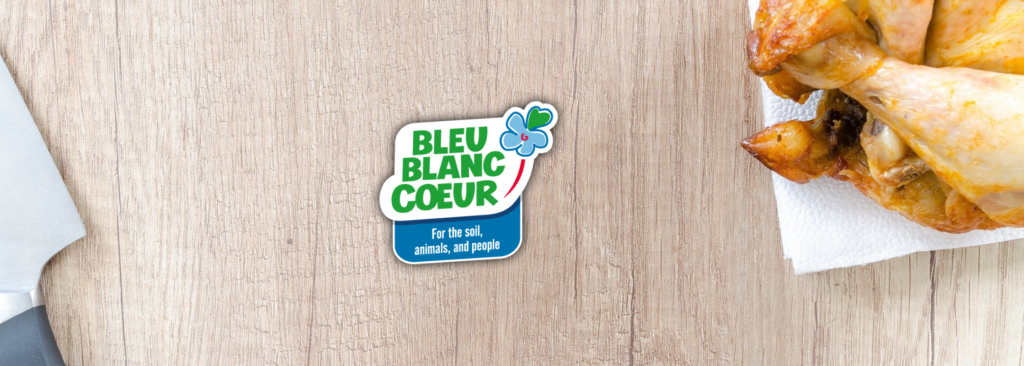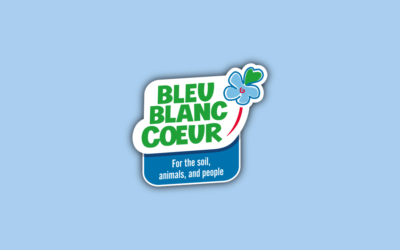Read the explanation of Dr. Bernard Schmitt* who presents the nutritional qualities of a Bleu-Blanc-Coeur chicken. He lingers on the importance of animal nutrition, and the real nutritional impact of the Bleu-Blanc-Coeur approach for lean meats such as chicken.
The quality of the feed determines the quality of the meat and the nature of the lipids in its composition
Today, it is an evidence that the feed quality of the animals’ nutrition determines the quality of a meat and the nature of lipids entering in its composition. This criterion is essential, but the consumer, more and more aware, brings in other considerations in his choices:
- Production model;
- Decrease of greenhouse emissions;
- Absence of pesticides, antibiotics, and GMO;
- Energy and protein waste control;
He appeals for a sustainable and responsible agriculture, which at the same time guarantees the food self-sufficiently, the health of the soil, animals and people, and which is accessible to the greatest number of persons while ensuring a decent income for farmers.
The issues are complexes
- Nutritionals, in line with the requirements of public health and the prevention of major civilization diseases;
- Environmental, in line with the breeding methods, the animal welfare for which the requirements often go beyond the currently legislative frame and the distribution circuits with the traceability of products throughout the food chain;
Facing with this challenge, for more 20 years the Bleu-Blanc-Coeur organization has been positioning itself. It has made it its hobbyhorse and its branding image through specifications for each production sector, covering:
- An obligation of means ensuring in the same time a sanitary and nutritional security by the choice of cereal seeds and protein oilseeds (DIVAL index to monitor the vegetal diversity of the animal diet) and ensure a technical Omega-3 index of 2,5 per kg of food on the chicken lifespan
- A result obligation, the objective is to conciliate as many criteria as possible in order to offer to the consumer a product of “high nutritional environmental quality”, ethically acceptable, ensuring accessibility to as many people as possible and guaranteeing the respect of public health criterion: w6/w3 ratio <4 ; low C16:0/w3 ratio, LA/ALA** ratio <5 ratio, rich in vitamins and trace elements, absence of GMO trace, nor antibiotics and pesticides traces. It should be noted that there is no limitation to associate the Bleu-Blanc-Coeur approach with other approaches.
Bernard Schmitt explains you why choosing Bleu-Blanc-Coeur Chicken?

Bernard Schmitt, the co-chairman of Bleu-Blanc-Coeur, also nutritionist doctor explains that our association gives priority to the nutritional quality.
On the field, even more advanced breeding practices, aren’t necessary correlated with the achievement of a high nutritional quality. It refers to the consideration that it is essentially linking to animals’ diet. This is why we require a particular attention how we fed the animals in order to ensure an obligation of results in the food.
The chicken meat is an important food in our diet and, even if the chicken is a lean meat, its appears interesting to improve its fatty acids** contents, as its fat content varied greatly according to the piece considered. CIQUAL database: The French food composition database of a unit of ANSES (French agency for food, environmental and occupational health safety) gives figures ranging from 2% (white chicken meat without the skin) to 14,5% (brown chicken meat with the skin). If the content of different pieces does not vary significantly between a standard chicken of 40, 81 or 110 days and a Bleu-Blanc-Coeur chicken over the same period, the fatty acid compositions are very different.
Whatever the piece considered, the Bleu-Blanc-Coeur chicken provides twice more total omega-3 and three times more ALA. In addition, the SFA/w3 ratio achieving 15 as standard value, is less than 5 for Bleu-Blanc-Coeur production, matching with the public health target ≤ at 5. Also, the LA/ALA ratio, which is one of the best nutritional balance index, goes from 15 for a normal to ≤ 4 for a BBC chicken (matching with the Recomandated Diatary Allowance). In other words, even if the chicken is a low-fat provider, the FA profile, a criterion much more decisive in public health than the sum of the fats, is optimized and thus effectively contributes to normalize the nutrient intakes.
And now, will you eat Bleu-Blanc-Coeur?

* Bernard Schmitt is the co-chairman of our association Bleu-Blanc-Coeur, he is also a nutrionist doctor who heads the Centre for Study and Research in Human Nutrition and the principal investigator of numerous clinical studies.
** You want to learn more about fatty acids? Read our article on the lipids!






 Home
Home


